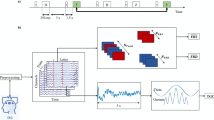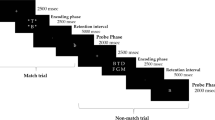Abstract
Previous functional imaging studies have pointed to the compensatory recruitment of cortical circuits in old age in order to counterbalance the loss of neural efficiency and preserve cognitive performance. Recent electroencephalographic (EEG) analyses reported age-related deficits in the amplitude of an early positive–negative working memory (PNwm) component as well as changes in working memory (WM)-load related brain oscillations during the successful performance of the n-back task. To explore the age-related differences of EEG activation in the face of increasing WM demands, we assessed the PNwm component area, parietal alpha event-related synchronization (ERS) as well as frontal theta ERS in 32 young and 32 elderly healthy individuals who successfully performed a highly WM demanding 3-back task. PNwm area increased with higher memory loads (3- and 2-back > 0-back tasks) in younger subjects. Older subjects reached the maximal values for this EEG parameter during the less WM demanding 0-back task. They showed a rapid development of an alpha ERS that reached its maximal amplitude at around 800 ms after stimulus onset. In younger subjects, the late alpha ERS occurred between 1,200 and 2,000 ms and its amplitude was significantly higher compared with elders. Frontal theta ERS culmination peak decreased in a task-independent manner in older compared with younger cases. Only in younger individuals, there was a significant decrease in the phasic frontal theta ERS amplitude in the 2- and 3-back tasks compared with the detection and 0-back tasks. These observations suggest that older adults display a rapid mobilization of their neural generators within the parietal cortex to manage very low demanding WM tasks. Moreover, they are less able to activate frontal theta generators during attentional tasks compared with younger persons.



Similar content being viewed by others
References
Babiloni C, Babiloni F, Carducci F, Cappa SF, Cincotti F, Del Percio C, Miniussi C, Moretti DV, Rossi S, Sosta K, Rossini PM (2004) Human cortical responses during one-bit short-term memory. A high-resolution EEG study on delayed choice reaction time tasks. Clin Neurophysiol 115:161–170
Baddeley A, Emslie H, Nimmo-Smith L (1994) The Doors and People Test: a test of visual and verbal recall and recognition. Thames Valley Test, Bury St Edmonds
Busch NA, Herrmann CS (2003) Object-load and feature-load modulate EEG in a short-term memory task. NeuroReport 14:1721–1724
Buschke H, Sliwinski MJ, Kuslansky G (1997) Lipton RB. Diagnosis of early dementia by the Double Memory Test: encoding specificity improves diagnostic sensitivity and specificity. Neurology 48:989–997
Butters N, Granholm E, Salmon DP, Grant I, Wolfe J (1987) Episodic and semantic memory: a comparison of amnesic and demented patients. J Clin Exp Neuropsychol 9:479–497
Cabeza R, Anderson ND, Locantore JK, McIntosh AR (2002) Aging gracefully: compensatory brain activity in high-performing older adults. Neuroimage 17:1394–1402
Callicott JH, Mattay VS, Bertolino A, Finn K, Coppola R, Frank JA, Goldberg TE, Weinberger DR (1999) Physiological characteristics of capacity constraints in working memory as revealed by functional MRI. Cereb Cortex 9:20–26
Cook IA, Bookheimer SY, Mickes L, Leuchter AF, Kumar A (2007) Aging and brain activation with working memory tasks: an fMRI study of connectivity. Int J Geriatr Psychiatry 22:332–342
Cowan N (1984) On short and long auditory stores. Psychol Bull 96:341–370
Cowan N (1988) Evolving conceptions of memory storage, selective attention, and their mutual constraints within the human information-processing system. Psychol Bull 104:163–191
Davis SW, Dennis NA, Daselaar SM, Fleck MS, Cabeza R (2008) Que PASA? The posterior-anterior shift in aging. Cereb Cortex 18:1201–1209
Deiber M-P, Missonnier P, Bertrand O, Gold G, Costa-Fazio L, Ibañez V, Giannakopoulos P (2007) Distinction of perceptual and attentional processing in working memory tasks: a study of phase-locked and induced oscillatory brain dynamics. J Cogn Neurosci 19:158–172
Emery L, Heaven TJ, Paxton JL, Braver TS (2008) Age-related changes in neural activity during performance matched working memory manipulation. Neuroimage 42:1577–1586
Folstein MF, Folstein SE, McHugh PR (1975) “Mini-mental state”. A practical method for grading the cognitive state of patients for the clinician. J Psychiatr Res 12:189–198
Freunberger R, Fellinger R, Sauseng P, Gruber W, Klimesch W (2003) Dissociation between phase-locked and nonphase-locked alpha oscillations in a working memory task. Hum Brain Mapp 30:3417–3425
Friedman D (2000) Event-related brain potential investigations of memory and aging. Biol Psychol 54:175–206
Gevins A, Smith ME, McEvoy L, Yu D (1997) High-resolution EEG mapping of cortical activation related to working memory: effects of task difficulty, type of processing, and practice. Cereb Cortex 7:374–385
Ghent L (1956) Perception of overlapping and embedded figures by children of different ages. Am J Psychol 69:575–581
Goldberg TE, Berman KF, Fleming K, Ostrem J, Van Horn JD, Esposito G, Mattay VS, Gold JM, Weinberger DR (1998) Uncoupling cognitive workload and prefrontal cortical physiology: a PET rCBF study. Neuroimage 7:296–303
Grabner RH, Fink A, Stipacek A, Neuper C, Neubauer AC (2004) Intelligence and working memory systems: evidence of neural efficiency in alpha band ERD. Brain Res Cogn Brain Res 20:212–225
Homan R, Herman J, Purdy P (1987) Cerebral location of international 10–20 system electrode placement. Electroencephalogr Clin Neurophysiol 66:376–382
Jaeggi SM, Schmid C, Buschkuehl M, Perrig WJ (2009) Differential age effects in load-dependent memory processing. Neuropsychol Dev Cogn B Aging Neuropsychol Cogn 16:80–102
Jensen O, Tesche CD (2002) Frontal theta activity in humans increases with memory load in a working memory task. Eur J Neurosci 15:1395–1399
Jensen O, Gelfand J, Kounios J, Lisman JE (2002) Oscillations in the alpha band (9–12 Hz) increase with memory load during retention in a short-term memory task. Cereb Cortex 12:877–882
Jokisch D, Jensen O (2007) Modulation of gamma and alpha activity during a working memory task engaging the dorsal or ventral stream. J Neurosci 27:3244–3251
Kahana MJ, Sekuler R, Caplan JB, Kirschen M, Madsen JR (1999) Human theta oscillations exhibit task dependence during virtual maze navigation. Nature 399:781–784
Kaplan EF, Goodglass H, Weintraub S (1983) The Boston naming test. Lea and Febiger, Philadelphia
Karrasch M, Laine M, Rapinoja P, Krause CM (2004) Effects of normal aging on event-related desynchronization/synchronization during a memory task in humans. Neurosci Lett 366:18–23
Kawasaki M, Kitajo K, Yamaguchi Y (2010) Dynamic links between theta executive functions and alpha storage buffers in auditory and visual working memory. Eur J Neurosci 31:1683–1689
Klimesch W (1999) EEG alpha and theta oscillations reflect cognitive and memory performance: a review and analysis. Brain Res Brain Res Rev 29:169–195
Klimesch W, Freunberger R, Sauseng P, Gruber W (2008) A short review of slow phase synchronization and memory: evidence for control processes in different memory systems? Brain Res 1235:31–44
Kolev V, Yordanova J, Basar-Eroglu C, Basar E (2002) Age effects on visual EEG responses reveal distinct frontal alpha networks. Clin Neurophysiol 113:901–910
Krause CM, Sillanmäki L, Koivisto M, Saarela C, Häggqvist A, Laine M, Hämäläinen H (2000) The effects of memory load on event-related EEG desynchronization and synchronization. Clin Neurophysiol 111:2071–2078
Krause CM, Pesonen M, Hämäläinen H (2010) Brain oscillatory 4–30 Hz electroencephalogram responses in adolescents during a visual memory task. Neuroreport 21:767–771
Mattay VS, Fera F, Tessitore A, Hariri AR, Berman KF, Das S, Meyer-Lindenberg A, Goldberg TE, Callicott JH, Weinberger DR (2006) Neurophysiological correlates of age-related changes in working memory capacity. Neurosci Lett 392:32–37
McEvoy LK, Pellouchoud E, Smith ME, Gevins A (2001) Neurophysiological signals of working memory in normal aging. Brain Res Cogn Brain Res 11:363–376
Milliken GA, Johnson DE (1984) Designed experiments, vol 1. Van Nostrand Reinhold, New York
Milner B (1971) Interhemispheric differences in the localization of psychological processes in man. Br Med Bull 27:272–277
Missonnier P, Leonards U, Gold G, Palix J, Ibanez V, Giannakopoulos P (2003) A new electrophysiological index for working memory load in humans. Neuroreport 14:1451–1455
Missonnier P, Gold G, Leonards U, Costa-Fazio L, Michel JP, Ibanez V, Giannakopoulos P (2004) Aging and working memory: early deficits in EEG activation of posterior cortical areas. J Neural Transm 111:1141–1154
Missonnier P, Gold G, Fazio-Costa L, Michel JP, Mulligan R, Michon A, Ibanez V, Giannakopoulos P (2005) Early event-related potential changes during working memory activation predict rapid decline in mild cognitive impairment. J Gerontol A Biol Sci Med Sci 60:660–666
Onofrj M, Thomas A, Iacono D, D’Andreamatteo G, Paci C (2001) Age-related changes of evoked potentials. Neurophysiol Clin 31:83–103
Onton J, Delorme A, Makeig S (2005) Frontal midline EEG dynamics during working memory. Neuroimage 27:341–356
Palva S, Palva JM (2007) New vistas for alpha-frequency band oscillations. Trends Neurosci 30:150–158
Pesonen M, Hämäläinen H, Krause CM (2007) Brain oscillatory 4–30 Hz responses during a visual n-back memory task with varying memory load. Brain Res 1138:171–177
Poeck K (1985) Clues to the Nature of disruption to limb Praxis. In: Roy EA (ed) Neuropsychological studies of apraxia and related disorders. Elsevier, Amsterdam, pp 99–109
Raghavachari S, Kahana MJ, Rizzuto DS, Caplan JB, Kirschen MP, Bourgeois B, Madsen JR, Lisman JE (2001) Gating of human theta oscillations by a working memory task. J Neurosci 21:3175–3183
Rajah MN, McIntosh AR (2008) Age-related differences in brain activity during verbal recency memory. Brain Res 1199:111–125
Reitan RM (1958) Validity of the Trail Making Test as an indicator of organic brain damage. Percept Mot Skills 8:271–276
Reuter-Lorenz P (2002) New visions of the aging mind and brain. Trends Cogn Sci 6:394
Reuter-Lorenz PA, Jonides J, Smith EE, Hartley A, Miller A, Marshuetz C, Koeppe RA (2000) Age differences in the frontal lateralization of verbal and spatial working memory revealed by PET. J Cogn Neurosci 12:174–187
Richard CC, Veltmeyer MD, Hamilton RJ, Simms E, Paul R, Hermens D, Gordon E (2004) Spontaneous alpha peak frequency predicts working memory performance across the age span. Int J Psychophysiol 53:1–9
Rugg MD, Mark RE, Gilchrist J, Roberts RC (1997) ERP repetition effects in indirect and direct tasks: effects of age and interitem lag. Psychophysiology 34:572–586
Rypma B, D’Esposito M (2000) Isolating the neural mechanisms of age-related changes in human working memory. Nat Neurosci 3:509–515
Sauseng P, Klimesch W, Doppelmayr M, Pecherstorfer T, Freunberger R, Hanslmayr S (2005) EEG alpha synchronization and functional coupling during top-down processing in a working memory task. Hum Brain Mapp 26:148–155
Schnider A, Hanlon RE, Alexander DN, Benson DF (1997) Ideomotor apraxia: behavioral dimensions and neuroanatomical basis. Brain Lang 58:125–136
Stern Y (2009) Cognitive reserve. Neuropsychologia 47:2015–2028
Van der Linden M, Collette F, Seron X (1999) Adaptation française de la procédure de Grober et Buschke. Solal, Marseille
Wager TD, Smith EE (2003) Neuroimaging studies of working memory: a meta-analysis. Cogn Affect Behav Neurosci 3:255–274
Wechsler D (1955) Manual for the Wechsler adult intelligence scale. Psychological Corporation, New York
Wechsler D (1981) Manual for the Wechsler adult intelligence scale-revised. Psychological Corporation, New York
Author information
Authors and Affiliations
Corresponding author
Rights and permissions
About this article
Cite this article
Missonnier, P., Herrmann, F.R., Rodriguez, C. et al. Age-related differences on event-related potentials and brain rhythm oscillations during working memory activation. J Neural Transm 118, 945–955 (2011). https://doi.org/10.1007/s00702-011-0600-2
Received:
Accepted:
Published:
Issue Date:
DOI: https://doi.org/10.1007/s00702-011-0600-2




